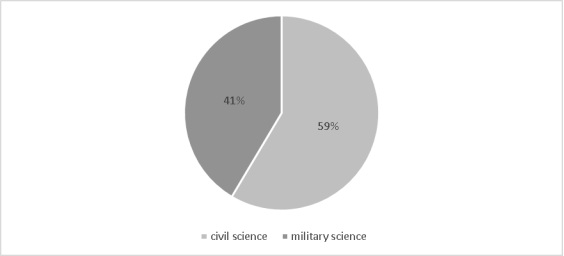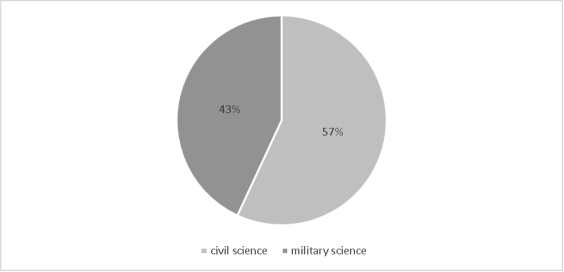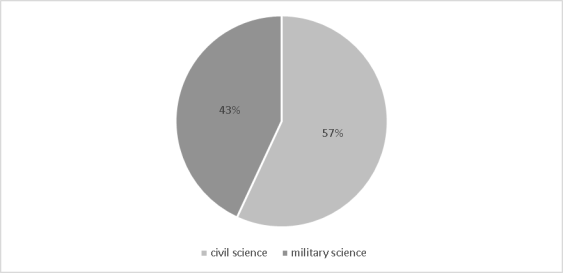Conversion seems to be one of possible ways to recover from the crisis. The article examines 3 options of carrying out conversion: international experience of carrying out conversion, Russian best practice in this sphere, the current state of military industrial complex in the Russian Federation. The conclusion sums up the ways required to promote the process within this country.
Keywords: conversion, crisis, military industry, Russian industry
In today’s economic situation we are searching for fundamentally new ways of development. Due to the recently imposed sanctions new technologies are not being imported and there exists a pressing need to make up for this loss. In Russia science has always developed alongside the military-industrial complex. These two areas are evidently interdependent. According to the Eurasian institute of competitiveness, Russia takes 42th place among innovative countries, but it notes high scientific and production potential of sectors, connected to the military-industrial complex and achievements in information and communication technology. [1]
As civilian technologies are not being developed in Russia as fast and as efficiently as in many developed countries, we suggest transferring tecnologies from a highly developed military sector. There are a lot of examples of the usage of military technologies in civilian sphere. One of the brightest is an invention of microwave ovens. In 1921 Albert Wallace Hull invented and patented magnetron. In 1940 British physicians John Randall and Harry Boot invented a resonant magnetron. Later on it was minified and used as a airplane radar. Sometime after the World war II an engineer Percy Spenser, being in close proximity to a running radar, discovered that a chocolate bar, that he had on him, had been melted. In 1946 he got a patent for microwave ovens and a company Raytheon, where he had been working, started producing them for soldiers. In 1962 a Japanese company Sharp started to produce ovens for households. Nowadays, nearly every house has a microwave oven and this has become possible due to the transferring of military tecnologies. That is the reason for our considering a conversion of military tecnologies into civilian sectors a way to boost Russian industry and to overcome the structural economic crisis.
Our suggestion might not be possible to realize, but in 2015–2016, according to Dmitry Rogosin — Deputy Prime Minister of Russia — the Russian Federation is going to disclose dual-purpose technologies.

Fig. 1. R&D expenses in 2011

Fig. 2. R&D expenses in 2012

Fig. 3. R&D expenses in2013
As we can observe from the above given diagrams, for 2011–2013 the share of expenses on military of Research and Development in general of a share of expenses on Research and Development remains unchanged. At the same time in absolute values, a definite growth by 100 billion rubles is observed.
The graphs show, that the expenses on a research in civil technologies are substantially higher than on a military research, but the military design bureaux spend their resources more properly. According to a general of a high rank, unfortunately, only 25 % Russian latest inventions are used for military purposes. That happens becase having got a particular order from the Ministry of Defence the design bureaus make not less valuable discoveries while fulfilling the received order. But such discoveries do not often have prospects for the development as they either can hardly be applied to the particular order or have rather debatable significance for the military sector. However such innovations could be highly appreciated by civil sectors. According to the latest data, the spendings on defence, including R&D, in 2015 increased by ₽600 bl. This sum equals yearly spendings on education and science.
It also should be mentioned, that there has already been an attempt to convert military technologies, but it has made the situation at design bureaus even worse. A privatization program took a significant part of governmental plans for introducing some prominent changes into the defense industry in 1991. The programs of transferring (from 1990) were urgently drown up. The following factors — the lack of a new military-technological policy, the rejection of the governmental control over the system of purchasing of weaponry and military enginery, which was assigned to the Ministry of defense, and abrupt cutdown on assignments — have led to fibrillation of this system. The consequences of that are still visible today. The government failed to withstand the consistently defined conversion and in 1992–1995 the situation in fact got out of the executive’s control. As a result the number of design bureaux and scientific-research institutes sharply reduced by a factor of 3 and the stuff was nearly halved. [2]
Table 1
The results of converting from the 90s
|
Year |
80s |
91–93 |
2000 |
|
scientific research institutes and design bureaus |
1800 |
1440 |
700 |
|
People |
4.5 million |
3.5 million |
2 million |
There are several ways to transfer technologies:
- Sole invasion of new markets.
Sole invasion of new markets means diversification of the manufactured products and successful entering into a neighboring civilian markets, which is provided by existing corporate research system.
- Merges and accusitions involving the redemption of assets in civil enterprises.
This is a market fighting method, which allows corporations to strengthen their position on the market, solve tactic (e.g. diversifying of selling network) or strategic (entering into new niches) objectives.
- Cooperative projects and strategic alliances.
They are organized by companies, which have their interests in different segments of the market and are interested in solving specific business-problems cooperatively.
Companies of military-industrial complex should note that going into new market will be the most successful if the sphere correlates with the major technological competence of a military enterprise. It can be the newest technological niche or such an innovative good or service which hav not formed a stable market yet.
To clarify this point we can turn to several examples in USA, where the first way of transferring has been widely used recently, as state military expenses are significantly decreased by $487 bl to 2022. Thus military corporations turn to producing civil goods to live through the currently unfavorable situation. For example, American aerospace giant Lockheed Martin used there aggregated military technology potential in management and analysis of big data and in complicated analyzing systems engineering to develop the most modern medical equipment. Concern Raytheon, that produces a wireless technology, also provides civilian services: monitoring of land surfaces, telecommunications, navigation. But we must bear in mind, that a civil market is rarely less competitive than a military one. Although civilian products, as a rule, take less time to develop and that is a great adtantage of civil market. [5]
The Textron company may illustrate such type of transfer as mergers and acquisitions in which the assets of civilian companies are redeemed. Textron Systems produces drones, sensors, military electronics and satellite systems, etc. Textron business is perfectly diversified. It is represented by enterprises of a civil sector (a world leader in production of electric vehicles for golf under the name E-Z-Go and a famous tool equipment producer Greenlee), as well as some mixed civilian and military product lines (Bell Helicopter — production of helicopters). Group of companies acquired Beechcraft Corporation (an American manufacturer of general aviation and military aircraft, ranging from light single-engined aircraft to twin-engined turboprop transports, and military trainers). As a result the company has entered the market of small aircrafts, and now corners nearly 60 % of the market. The product line of the Beechcraft definitely includes military aircrafts, but civil machines have brought the biggest part of company's income. Thus the deal strengthened Textron in the civil sector. [5]
The third way of transfer is cooperative projects and strategic alliances, that are organized by companies, which have their interests in different segments of the market and are interested in solving specific business-problems cooperatively. For example, Italian defense giant Finmeccanica signed an agreement with one of the world’s largest IT-corporation CISCO. According to the above mentioned agreement, Finmeccanica is provided with access to CISCO’s net technologies and vice versa. Also CISCO’s wide system of distribution, system of promotion on corporate and governmental levels can help the Italian company function efficiently on markets of complex solutions for “smart cities”. [3]
The above mentioned methods show that transfer of technology is a great stimulus to the development of a civilian industry and helps the latter with enviding new markets. A great example is the production of pilotless automobiles, which firstly were produced only for military purposes.
Beyond the shadow of a doubt we consider the third way of transfer the most efficient for Russia nowadays. Here is a number of reasons for that. Firstly, military companies do not implement their production capacity. The practice of using the first method previously led to bankruptcy of a large number of companies. The second way is also not appropriate as it is particularly useful for private military corporations. It requires large investing. That is why we cannot say that it will work in Russia, where all military companies are state-owned and most of civilian sector companies are owned by entrepreneurs. We also need to consider the fact, that there is an economic crisis and we are desperately trying to figure out a way to improve our economic situation. That also leads to the conclusion that merges and acquisitions is not the best option as a lot of companies in military have already created corporations and selling of one company equals selling a sector (for example UAC).
References:
- 5-ти летний отчет Евразийского института конкурентоспособности и компании Strategy Partners Group.
- Толкачев С. А. Теоретические аспекты функционирования рынка военных закупок диссертация: дис. …д.э.н. Москва, 2001
- Западная военная индустрия на гражданских рынках [Electronic resource] // Сайт navoine.info, [2016]. — Режим доступа: http://navoine.info/westmilciv-mark.html свободный. Загл. с экрана (03.03.2016)
- Военные заводы России загружены заказами под завязку [Electronic resource] // Сайт pravda.ru, [2016]. — Режим доступа: http://www.pravda.ru/news/economics/industry/militaryindustrial/26–03–2015/1254018-bombardirovshik-0/ свободный. Загл. с экрана (01.03.2016)
- Волков М. Н. Из колеи // национальная оборона.- 2016.- N 1







